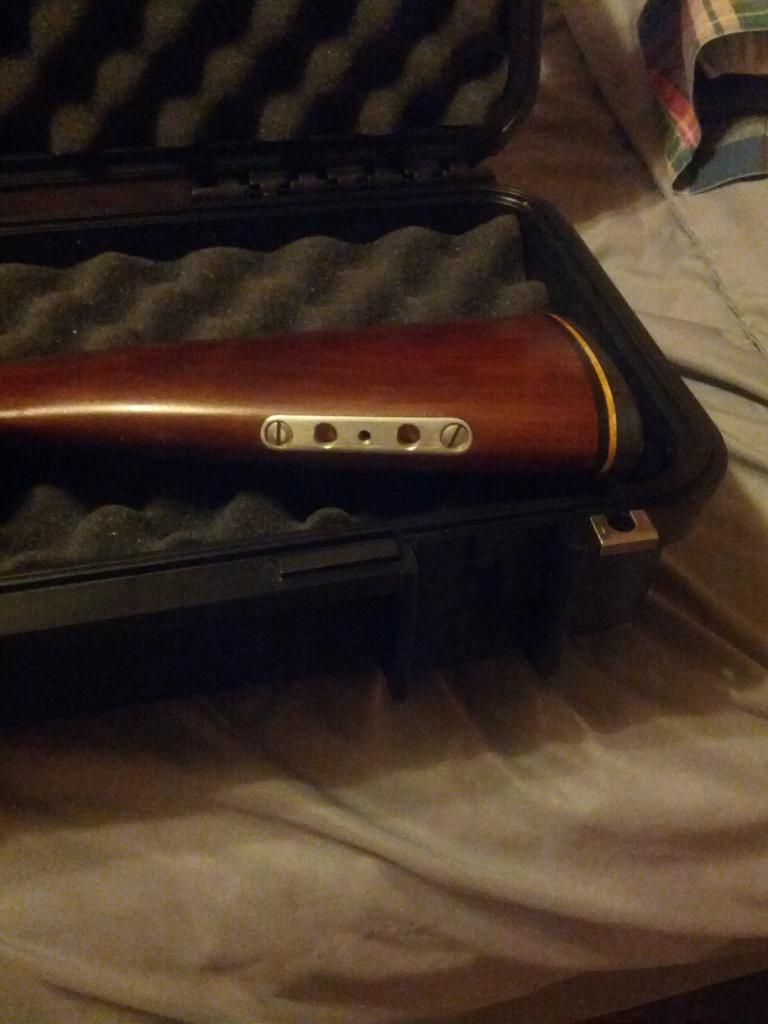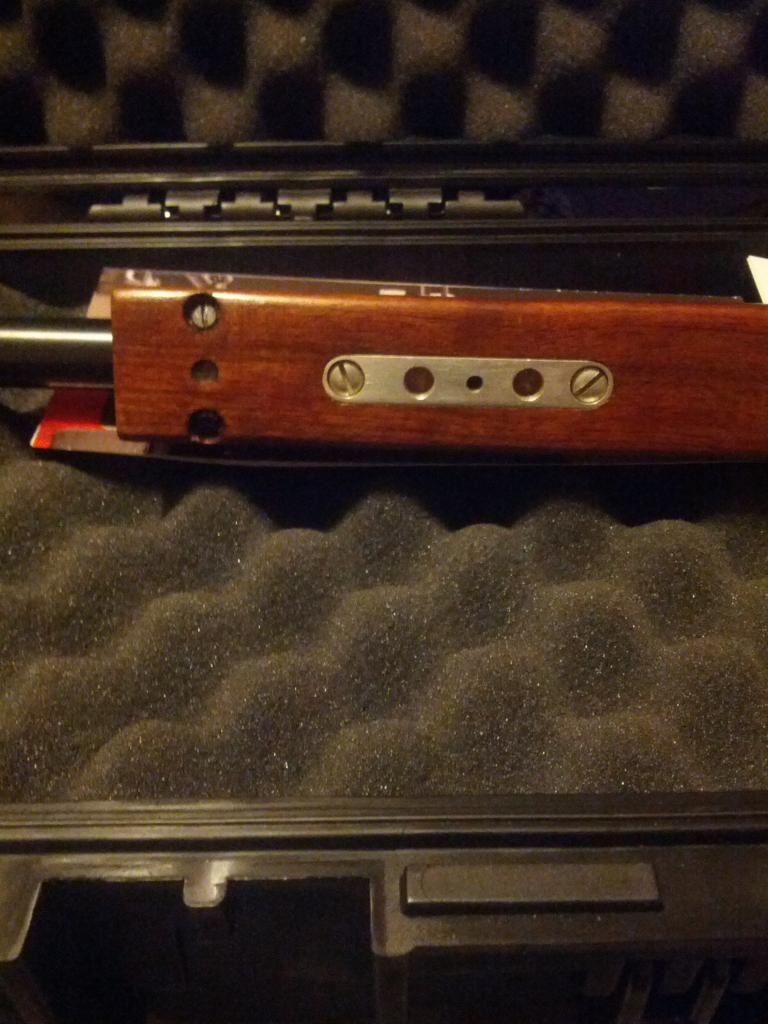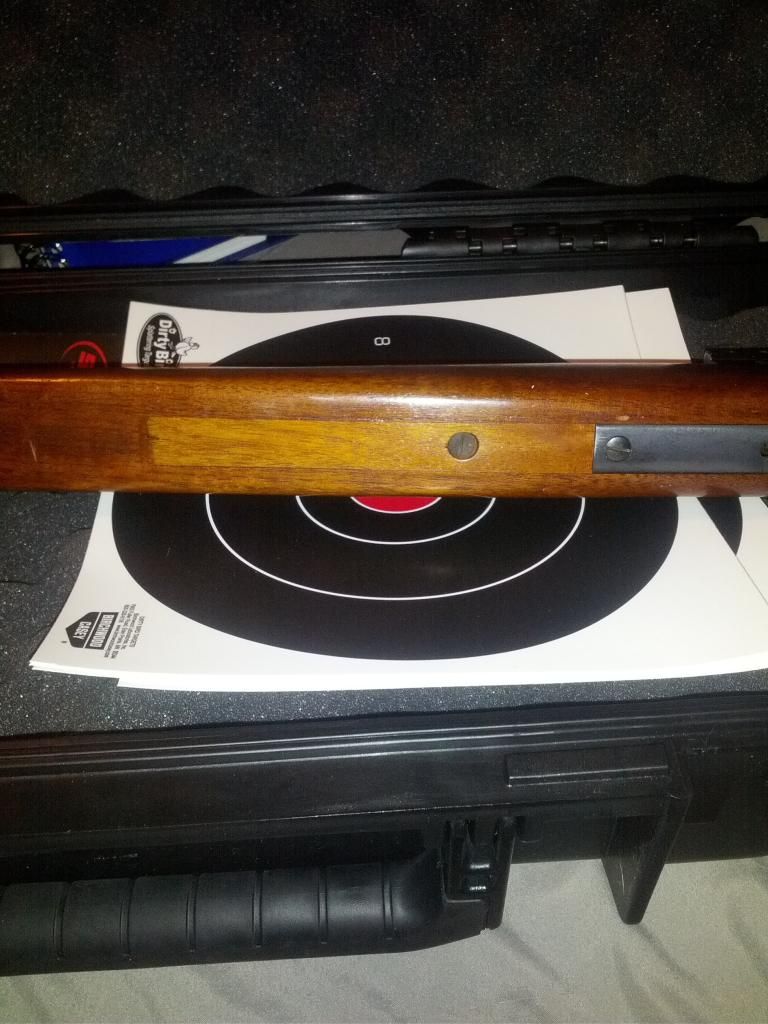OK folks I need a bit of help here. I'm fairly ceartian the stock on this fine arm is not factory. Maybe it is? Tis why I'm asking. It was gifted to me by my father for Christmas so its originality matters not. I wouldn't trade it for a million bucks. (Maybe two million) I would like to know however. The more important inquiry is what kind of attatchments are these suited for with the equipment that is installed on this particular stock. As you can see the barrel is free floated and adjustable for barrel contact. Are these threaded apparatuses just for sling swivels/pods maybe? Any info will help. Its quite hard to find good pics of original stocks. This is a 52-D by the way. Serial is 1152XXD. There is quite a bit of conflicting information on factory equipment. It does sound a bit like a "Model D" stock but I just can't find anything to compare it to. Again factory originality is of little concern although I am curious. Main reason is to see what's available for shooting attachments if any with this free float style stock. Thank you gentlemen. Pics coming directly.
You are using an out of date browser. It may not display this or other websites correctly.
You should upgrade or use an alternative browser.
You should upgrade or use an alternative browser.
Winchester Model 52 Experts.
- Thread starter mattL46
- Start date
Jim Watson
New member
Awaiting pictures with the unusual features pointed out.
@Jim Watson. If you would like any other pictures feel free to ask. It won't take me long to snap and post them. Just sitting in front of the T.V. The "Model D" stock according to Wikipedia (I know its not 100% reliable) is a free float stock. Introduced about the time mine was manufactured.
Jim Watson
New member
I am not an expert and don't know if the plates at sling swivel locations are Winchester factory parts or not.
The filled in groove ahead of the trigger guard was for an accessory rail, normally used for a palm rest to support the rifle with in the target rifle standing position. I don't know why it would have been removed and the groove filled in. Even if Dad were strictly a prone shooter, it would not have been in the way.
I was recently told by an experienced target shooter that the electric bedder, whose screws are seen just behind the foreend tip, was a dead end and that the rifles generally shot better left free floating without any tip pressure, no matter how finely adjusted.
The filled in groove ahead of the trigger guard was for an accessory rail, normally used for a palm rest to support the rifle with in the target rifle standing position. I don't know why it would have been removed and the groove filled in. Even if Dad were strictly a prone shooter, it would not have been in the way.
I was recently told by an experienced target shooter that the electric bedder, whose screws are seen just behind the foreend tip, was a dead end and that the rifles generally shot better left free floating without any tip pressure, no matter how finely adjusted.
Yeah its a mystery Jim. This rifle has been in my family for many years. I'm quite sure in the configuration your seeing it in. None of us are competition shooters. So dad nor his dad made the alterations. If anyone it would have been his dad. Possibly he aquired it missing the rail and filled the gap. Doubtful but not impossible. Its scary accurate the way it is. You called the screws on the for end "electric bedder" I've never heard of this. Care to elaborate?
Jim Watson
New member
The electric bedder is built around those two screws going in at a 45 deg angle just behind the foreend tip.
They came with a continuity tester, just a flashlight with wires and alligator clips instead of a switch. Connect a lead to one screw, the other to the barrel. Adjust the screws until each JUST turns on the light, indicating contact but no pressure. Then tweak the screws and shoot until you get best accuracy. Record the number of turns or clicks from first contact so you can get back to the setting for a particular lot of ammo.
Not really much help, most shooters gave up, backed out the screws and shot free floating.
They came with a continuity tester, just a flashlight with wires and alligator clips instead of a switch. Connect a lead to one screw, the other to the barrel. Adjust the screws until each JUST turns on the light, indicating contact but no pressure. Then tweak the screws and shoot until you get best accuracy. Record the number of turns or clicks from first contact so you can get back to the setting for a particular lot of ammo.
Not really much help, most shooters gave up, backed out the screws and shot free floating.
I'd have to see a full length stock picture to tell if it's a factory original that was modified with the metal parts shown.
Those metal plates are not Winchester's parts. Such things were often added to stocks to hold hand stops and other stuff the shooter wanted to use. The area under the fore end that appears to be filled with wood may have been where a rail for hand stops to be used. They could be set at different positions depending on shooter's size and positions used with a sling.
The fore end tuner screws are an idea from a smallbore match shooter (Al Freeland?) in the 1950's who thought they would help "tune" the barrel for best accuracy. Truth is, the way fore ends bend from sling tension and holding variables, such contact to the barrel was not repeatable from shot to shot. Remington tried that approach on their rimfire 40X match rifles. The best marksmen backed the adjustments all the way out and shot the rifle most accurate with free floating barrels. 'Twas based on the premise that a pad under a centerfire rifle's barrel at the fore end tip would improve accuracy; a bandaid on the stub of a cut off arm which for rifles, partially fixed the problem of a poorly bedded receiver.
Those metal plates are not Winchester's parts. Such things were often added to stocks to hold hand stops and other stuff the shooter wanted to use. The area under the fore end that appears to be filled with wood may have been where a rail for hand stops to be used. They could be set at different positions depending on shooter's size and positions used with a sling.
The fore end tuner screws are an idea from a smallbore match shooter (Al Freeland?) in the 1950's who thought they would help "tune" the barrel for best accuracy. Truth is, the way fore ends bend from sling tension and holding variables, such contact to the barrel was not repeatable from shot to shot. Remington tried that approach on their rimfire 40X match rifles. The best marksmen backed the adjustments all the way out and shot the rifle most accurate with free floating barrels. 'Twas based on the premise that a pad under a centerfire rifle's barrel at the fore end tip would improve accuracy; a bandaid on the stub of a cut off arm which for rifles, partially fixed the problem of a poorly bedded receiver.
Last edited:



